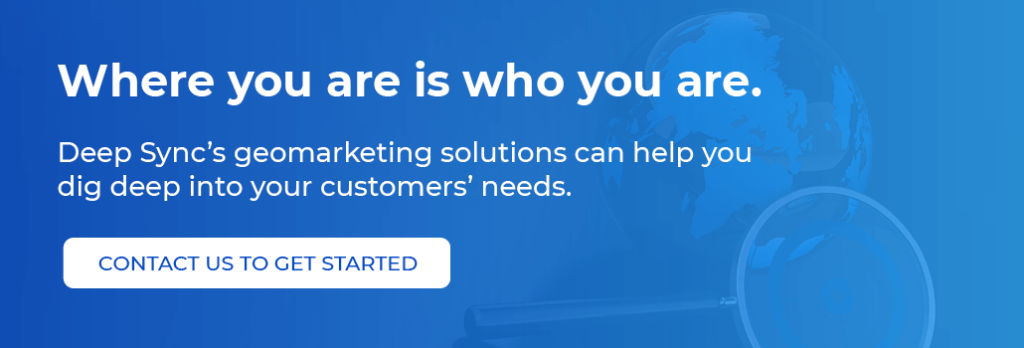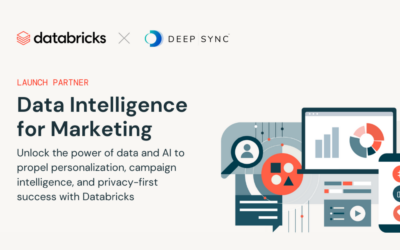In fact, geomarketing is a nearly $11 billion market, and that number is expected to triple in the next five years as location-based targeting evolves. Clearly, businesses see the value in targeting audiences based on their location!
If you’re interested in leveraging this powerful advertising technique but are unsure about where to begin, we’re here to provide you with all the information you need to build a successful geomarketing strategy. Throughout this guide, we’ll address:
- What Is Geomarketing?
- Geomarketing Variations
- Benefits of Geomarketing
- Best Practices for Incorporating Geomarketing into Your Strategy
Eager to learn more about location-based targeting and how it can enhance your current marketing strategies? Let’s kick things off with a brief overview.
What Is Geomarketing?
Geomarketing is the practice of using location data to serve marketing messages to a highly targeted audience. Essentially, geomarketing allows you to better serve your audience by targeting them based on location-related factors, enabling you to tailor your marketing to the products or services that appeal to their needs.

The core principle behind geomarketing is that “where you are is who you are.” In other words, where your customers live and spend their time can tell you a lot about them—including their likely wants and needs.
In terms of technology, geomarketing involves using location-based data to identify target audiences that work, live, or vacation in a specific location. This enables you to catch customers who are, based on their location, more likely to respond well to your advertising campaign.
Geomarketing Variations
As we mentioned, geomarketing is the larger practice of using location data to create targeted advertising campaigns. But, there are many different types of location-based marketing.
As you think about how geomarketing can strengthen your business’s marketing campaigns, take a look at some types of location-based targeting that you can take advantage of:
Location Data for Digital Marketing
Third-party data providers can help you build an audience based on geographic location. For example, with Deep Sync One’s Audience Builder, marketers and advertisers can build a custom audience using location-based filters. These filters include:
- ZIP Code
- DMA
- Carrier Route
- Radius
- City
- County
- State
Once you’ve built your audience, you can activate the same, exact audience on social channels, including Meta and TikTok.
Residential Mailing Lists for Saturation Mailings
Residential Mailing Lists for saturation mailings are types of mailing lists that enable you to send saturation mailings to every resident in a predetermined area. These lists can be determined by factors such as:
- ZIP Codes
- Neighborhoods
- Mail delivery routes
- Cities
- Counties
- States
- Congressional Districts
- Radius, and more.
Mailings are addressed to “Current Resident” to ensure high levels of deliverability. Contact names are available for a percentage of residential records and can be added to your list upon request. Consumer lists allow you to be more specific.
Consumer Lists
Consumer lists enable you to send messages to specific people or households that you’re hoping to reach. These lists include consumers’ names, home addresses, email addresses, and other essential demographic information that you can use to personalize your content.
A marketing list provider, like Deep Sync, can offer specialized lists of consumers, houses, apartments, and other target groups that have been compiled through geomapping tools. This data allows you to target individuals based on home or business address.
Benefits of Geomarketing
If you’re still weighing the pros and cons of adding location-based targeting into your current advertising strategies there are two main things you’ll want to consider: the core benefits of geomarketing and how specific geomarketing providers can help your business.
So what are those core benefits? With geolocation data informing your marketing campaigns, you will be able to:
- Reach your local audience more effectively. Geomarketing can boost your business’s brand awareness in the local community by showing residents that your offerings are relevant and valuable.
- Reach a highly targeted audience. Geomarketing can boost your business’s brand awareness in the local community by showing residents that your offerings are relevant and valuable.
- Reach a highly-targeted audience. Improve your marketing return on investment by tailoring ad campaigns to a specific audience that is more likely to be interested in your product or service.
- Reach your audience members across multiple touchpoints to build brand awareness and loyalty.It takes an average of eight touches before prospective customers feel inclined to make a purchase. No matter the industry, location-based targeting can help increase the number of touchpoints between your organization and its prospective audience members by supplementing your direct mail marketing with digital outreach across recipients’ mobile devices, tablets, and laptops.
There’s a reason that geomarketing is counted among some of the fastest-growing and most effective marketing strategies in the world. So, is geomarketing right for you?
What types of businesses can benefit from geomarketing?
Most businesses, regardless of size or type, can benefit from some kind of location-based targeting. Here are some examples of geomarketing in action:
- A real estate office is looking for homeowners in a lucrative neighborhood to see if they’d be interested in selling.
- A political campaign is looking to target a specific region, congressional district, or residential neighborhood.
- A local business is looking to reach more customers that live within a specific distance from their store.
- A nonprofit is looking to ask local residents for donations.
- A clothing store is looking to market winter apparel, so they target residents in the snowy Northeastern U.S.
Best Practices for Incorporating Geomarketing into Your Strategy
At this point, you might be ready to dive into geomarketing. If so, review these steps to carefully integrate geomarketing into your current marketing strategies:
Set goals.
There are several different types of geomarketing tools, each with its own uses, benefits, and modes of operation. So, before you jump in and start selecting your geomarketing tools, you need to ask yourself a few important questions about your main marketing objectives.
For example, are you looking to:
- Break into a new market?
- Increase local brand recognition?
- Boost traffic to your eCommerce store?
- Increase foot traffic to your physical location?
By taking a moment to consider what you want out of your geomarketing strategy, you’ll be far better equipped to choose the best tools and approach to suit your needs.
Define your target audience.
Once you’ve firmly established the main objectives for your geomarketing campaign, the question becomes: Who is the most important target audience for your particular goods, services, or campaign?
After all, geomarketing is a technique that can help you to identify where, when, and who is among your chosen audience—but only after you’ve drawn out the boundaries of the kinds of individuals you want to target. For example, for a geoframing tool to be effective, you need to have decided on a specific date and location to look back at before you can send advertisements to prospective consumers.
To effectively identify your target audience or audiences, you should:
- Review your audience data using internal and external sources. Your first and best resource for finding potential audiences is looking at your current consumer records. Additionally, maintaining high data hygiene standards and supplementing your records with third-party data from a data append service provider can help you to fill in informational gaps, discover new lookalike audience segments, and further narrow down your target audience.
- Create user personas. Personas are archetypes of the consumers who typically buy your products or engage with your marketing materials. By using consumer data to create personas, you can better understand the specific behaviors, goals, and motivators of your real-life audience, allowing you to more effectively build out your messaging, guess how they might behave, and predict where they might spend their time.
Once you have defined your goals and audiences, you can then figure out how to best reach them. You’ll want to consider factors like their location and what channels they’ve typically engaged with previously. Then, you can start building your campaign!
Optimize your marketing messages.
Once you’ve narrowed down your target audience, location, and channels, you’ll need to develop a compelling message that captures your audiences’ attention and encourages them to engage with you further. When you’re designing your messaging, consider:
- Personalizing your outreach with audience members’ preferred names and engagement histories, as well as dynamic text and images.
- Ensuring your direct mail and digital ads are well-designed and effectively and consistently branded to your organization.
- Offering a variety of possible touchpoints with prospective customers through multiple channels and platforms.
Wherever your message appears, it should include a call to action that brings your audience to the next step in their sales journey.
Optimize your digital content for SEO and user-friendliness.
Finally, you’ll want to make sure your digital marketing presence is well-designed and optimized for local SEO.
Once you’ve successfully brought your audience members to your website, you want to make it as easy as possible to convert those visitors into purchasers. To give your potential customers a positive experience and set yourself up for success, follow these best practices:
- Use locally-relevant keywords. Conduct keyword research to identify search terms that are relevant to your product and key demographics. Then, use these keywords in specific page headings and titles.
- Publish quality and timely content. Users and search engine crawlers alike look at a page’s usefulness and accuracy to determine its value. Make sure your content is proofread and up-to-date.
- Incorporate simple navigation. Direct your direct mail and/or digital ad audience to a simple landing page or use clearly labeled menus and call-to-action buttons to direct visitors to important product and purchase pages. As you do this, streamline the checkout process. For example, visitors don’t want to have to first go through the rigamarole of creating an account in order to make a simple purchase.
- Prioritize site accessibility. Ensure your visual elements are optimized for accessibility by providing transcripts for video content, including descriptive alternative text for images, and offering tools to change text contrast and size.
- Optimize for all devices. Especially if you’re marketing directly to mobile devices, many of your visitors will access your website via their phones. Thus, it should have a responsive design that adjusts to fit different screen sizes.
Ultimately, even when your geomarketing strategy sends the perfect consumers your way, the quality of your website will determine whether they take the next steps to make a purchase.
In Summary
As the world of marketing and marketing technology rapidly evolves, this is both an exciting and daunting time to be a business leader.
For further information on the different ways you can incorporate geomarketing into your marketing strategy, take a look at these additional resources:
- Residential Mailing Lists: The Ultimate Guide. Mailing lists can be an especially powerful form of geomarketing to power your direct mail campaigns. Learn more and find the best provider for this service.
- Our datasets. If you’re looking to reach new movers, new homeowners, students, young adults, or any other specific consumer demographic—we have the data you need! Contact us to learn more, or make a free Deep Sync One account to start building your perfect audience.













0 Comments